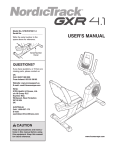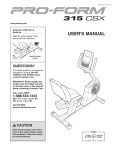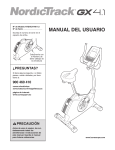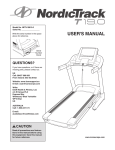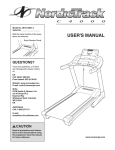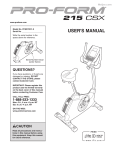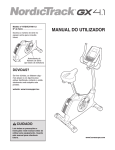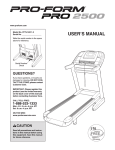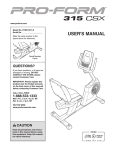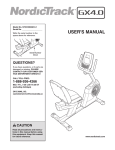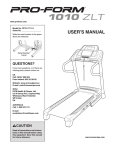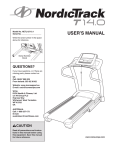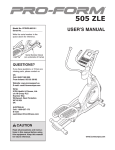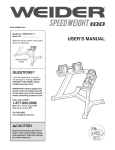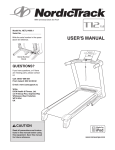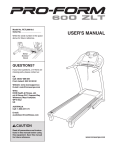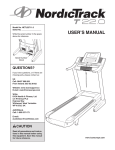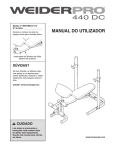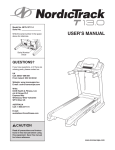Download USER`S MANUAL - Icon Heath & Fitness
Transcript
Model No. NTEVEX74911.0 Serial No. Write the serial number in the space above for reference. USER'S MANUAL Serial Number Decal (under frame) QUESTIONS? If you have questions, or if there are missing parts, please contact us: UK Call: 08457 089 009 From Ireland: 053 92 36102 Website: www.iconsupport.eu E-mail: [email protected] Write: ICON Health & Fitness, Ltd. c/o HI Group PLC Express Way Whitwood, West Yorkshire WF10 5QJ UK AUSTRALIA Call: 1-800-237-173 E-mail: [email protected] CAUTION Read all precautions and instructions in this manual before using this equipment. Keep this manual for future reference. www.iconeurope.com TABLE OF CONTENTS WARNING DECAL PLACEMENT . . . . . . . . . . . . . . . . . . . . . . . . . . . . . . . . . . . . . . . . . . . . . . . . . . . . . . . . . . . . . .2 IMPORTANT PRECAUTIONS . . . . . . . . . . . . . . . . . . . . . . . . . . . . . . . . . . . . . . . . . . . . . . . . . . . . . . . . . . . . . . . .3 BEFORE YOU BEGIN . . . . . . . . . . . . . . . . . . . . . . . . . . . . . . . . . . . . . . . . . . . . . . . . . . . . . . . . . . . . . . . . . . . . . .4 PART IDENTIFICATION CHART . . . . . . . . . . . . . . . . . . . . . . . . . . . . . . . . . . . . . . . . . . . . . . . . . . . . . . . . . . . . . .5 ASSEMBLY . . . . . . . . . . . . . . . . . . . . . . . . . . . . . . . . . . . . . . . . . . . . . . . . . . . . . . . . . . . . . . . . . . . . . . . . . . . . . . .6 HOW TO USE THE HEART RATE MONITOR . . . . . . . . . . . . . . . . . . . . . . . . . . . . . . . . . . . . . . . . . . . . . . . . . . .11 HOW TO USE THE EXERCISE BIKE . . . . . . . . . . . . . . . . . . . . . . . . . . . . . . . . . . . . . . . . . . . . . . . . . . . . . . . . .12 MAINTENANCE AND TROUBLESHOOTING . . . . . . . . . . . . . . . . . . . . . . . . . . . . . . . . . . . . . . . . . . . . . . . . . . .21 EXERCISE GUIDELINES . . . . . . . . . . . . . . . . . . . . . . . . . . . . . . . . . . . . . . . . . . . . . . . . . . . . . . . . . . . . . . . . . . .23 PART LIST . . . . . . . . . . . . . . . . . . . . . . . . . . . . . . . . . . . . . . . . . . . . . . . . . . . . . . . . . . . . . . . . . . . . . . . . . . . . . .25 EXPLODED DRAWING . . . . . . . . . . . . . . . . . . . . . . . . . . . . . . . . . . . . . . . . . . . . . . . . . . . . . . . . . . . . . . . . . . . .27 ORDERING REPLACEMENT PARTS . . . . . . . . . . . . . . . . . . . . . . . . . . . . . . . . . . . . . . . . . . . . . . . . . .Back Cover RECYCLING INFORMATION . . . . . . . . . . . . . . . . . . . . . . . . . . . . . . . . . . . . . . . . . . . . . . . . . . . . . . . . .Back Cover WARNING DECAL PLACEMENT This drawing shows the location(s) of the warning decal(s). If a decal is missing or illegible, see the front cover of this manual and request a free replacement decal. Apply the decal in the location shown. Note: The decal(s) may not be shown at actual size. Misuse of this machine may result in serious injury. Read user’s manual prior to use and follow all warnings and instructions. Do not allow children on or around machine. User weight must not exceed 275 pounds. This product should always be used on a level surface. This product is not intended for therapeutic use. Replace label if damaged, illegible, or removed. NORDICTRACK is a registered trademark of ICON IP, Inc. 2 IMPORTANT PRECAUTIONS WARNING: To reduce the risk of serious injury, read all important precautions and instructions in this manual and all warnings on your exercise bike before using your exercise bike. ICON assumes no responsibility for personal injury or property damage sustained by or through the use of this product. 1. Before beginning any exercise program, consult your physician. This is especially important for persons over age 35 or persons with pre-existing health problems. 8. Keep children under age 12 and pets away from the exercise bike at all times. 3. It is the responsibility of the owner to ensure that all users of the exercise bike are adequately informed of all precautions. 10. The exercise bike should not be used by persons weighing more than 275 lbs. (125 kg). 9. Wear appropriate clothes while exercising; do not wear loose clothes that could become caught on the exercise bike. Always wear athletic shoes for foot protection. 2. Use the exercise bike only as described in this manual. 4. The exercise bike is intended for home use only. Do not use the exercise bike in a commercial, rental, or institutional setting. 11. The pulse sensor is not a medical device. Various factors, including the user's movement, may affect the accuracy of heart rate readings. The pulse sensor is intended only as an exercise aid in determining heart rate trends in general. 5. Keep the exercise bike indoors, away from moisture and dust. Do not put the exercise bike in a garage or covered patio, or near water. 12. Always keep your back straight while using the exercise bike; do not arch your back. 6. Place the exercise bike on a level surface with at least 2 ft. (0.6 m) of clearance around the exercise bike. To protect the floor or carpet from damage, place a mat under the exercise bike. 13. Over exercising may result in serious injury or death. If you feel faint or if you experience pain while exercising, stop immediately and cool down. 7. Inspect and properly tighten all parts regularly. Replace any worn parts immediately. 3 BEFORE YOU BEGIN Thank you for selecting the revolutionary NORDICTRACK® GX 4.1 exercise bike. Cycling is an effective exercise for increasing cardiovascular fitness, building endurance, and toning the body. The GX 4.1 exercise bike provides an impressive selection of features designed to make your workouts at home more effective and enjoyable. after reading this manual, please see the front cover of this manual. To help us assist you, note the product model number and serial number before contacting us. The model number and the location of the serial number decal are shown on the front cover of this manual. Before reading further, please familiarize yourself with the parts that are labeled in the drawing below. For your benefit, read this manual carefully before you use the exercise bike. If you have questions Length: 3 ft. 5 in. (104 cm) Width: 1 ft. 11 in. (58 cm) Weight: 82 lbs. (37 kg) Console Handlebar Handgrip Pulse Sensor Adjustment Knob Seat Seat Adjustment Knob Seat Post Knob Seat Post Pedal/Strap Wheel Leveling Knob Leveling Foot 4 PART IDENTIFICATION CHART See the drawings below to identify the small parts needed for assembly. The number in parentheses below each drawing is the key number of the part, from the PART LIST near the end of this manual. The number following the key number is the quantity needed for assembly. Note: If a part is not in the hardware kit, check to see if it has been preassembled. To avoid damaging parts, do not use power tools for assembly. M8 Locknut (72)–4 M8 Split Washer (75)–8 M4 x 5mm Patch Screw (91)–1 M8 Washer (43)–2 M4 x 16mm Screw (90)–6 M10 x 95mm Patch Screw (76)–4 M8 x 20mm Patch Screw (74)–4 M6 x 70mm Bolt Set (50)–1 M6 x 60mm Bolt Set (51)–1 5 M4 x 22mm Screw (94)–2 ASSEMBLY • Assembly requires two persons. • In addition to the included tool(s), assembly requires the following tools: • Place all parts in a cleared area and remove the packing materials. Do not dispose of the packing materials until you complete all assembly steps. one adjustable wrench one Phillips screwdriver Assembly may be easier if you have a socket set or a set of ratchet wrenches. To avoid damaging parts, do not use power tools. • To identify small parts, see page 5. 1. Attach the Rear Stabilizer (3) to the Frame (1) with two M10 x 95mm Patch Screws (76). 1 3 1 76 2. Attach the Front Stabilizer (2) to the Frame (1) with two M10 x 95mm Patch Screws (76). 2 2 1 6 76 3. Loosen the Adjustment Knob (27) in the Frame (1) a few turns. 3 Orient the Seat Post (6) as shown. Then, pull the Adjustment Knob (27) outward and insert the Seat Post into the Frame (1). Adjustment Holes 6 Slide the Seat Post (6) upward or downward to the desired position, and release the Adjustment Knob (27). 1 Move the Seat Post (6) upward or downward slightly to make sure that the Adjustment Knob (27) is engaged in one of the adjustment holes in the Seat Post. Then, tighten the Adjustment Knob. 4. Orient the Seat (23) and the Seat Carriage (24) as shown. 4 Attach the Seat (23) to the Seat Carriage (24) with four M8 Locknuts (72) and four M8 Split Washers (75). 23 91 Slide the Seat Carriage (24) onto the Seat Post (6). Then, slide the Seat Carriage all the way forward and tighten the Seat Adjustment Knob (26). 24 Attach an M4 x 5mm Patch Screw (91) to the rear of the Seat Post (6). 75 72 7 26 27 6 5. Apply some of the included grease to an M6 x 70mm Bolt Set (50). 5 Orient the Handlebar (5) and the Upright (4) as shown. 50 While a second person holds the Handlebar (5) near the Upright (4), insert the Extension Wire (59) upward through the Handlebar. Grease Tip: Avoid pinching the Extension Wire (59). Attach the Handlebar (5) to the Upright (4) with the M6 x 70mm Bolt Set (50) and two M8 Washers (43). 59 43 5 51 51 4 Then, attach an M6 x 60mm Bolt Set (51) through the lower bracket on the Handlebar (5). 43 50 Avoid pinching the Extension Wire (59) 6. While another person holds the Console (13) near the Handlebar (5), insert the long receiver wire (A) on the Console through the Handlebar as shown. 6 Avoid pinching the wires Then, connect the other wires on the Console (13) to the Extension Wire (59) and to the Pulse Wire (61). 13 Tip: Avoid pinching the wires. Attach the Console (13) to the Handlebar (5) with four M4 x 16mm Screws (90). 59 61 5 A 90 8 7. Orient the Upright (4) assembly and the Pivot Cover (12) as shown. 7 Slide the Pivot Cover (12) upward to the Handlebar (5). Tip: Bend and flex the Pivot Cover slightly to slide it over the Handlebar. Avoid pinching the wires. Connect the long receiver wire (A) to the Receiver Wire (B). 94 Tip: Avoid pinching the wires. Attach the Pivot Cover (12) to the Handlebar (5) with two M4 x 16mm Screws (90) and two M4 x 22mm Screws (94). 5 Hole A Adjustment Holes 90 Pivot the Handlebar (5) until the hole in the Handlebar is aligned with an adjustment hole in the Upright (4). 27 Tighten an Adjustment Knob (27) into the Handlebar (5) and an adjustment hole in the Upright (4). Make sure that the Adjustment Knob is engaged in one of the adjustment holes. 8. Slide the Front Shield Cover (7) upward onto the Upright (4). B 4 12 94 90 8 While another person holds the Upright (4) near the Frame (1), connect the Extension Wire (59) to the Main Wire (58). Insert the Upright (4) into the Frame (1). Avoid pinching the wires Tip: Avoid pinching the wires. Attach the Upright (4) with four M8 x 20mm Patch Screws (74) and four M8 Split Washers (75). 7 Slide the Front Shield Cover (7) downward to the Frame (1) and press it into place. 74 4 75 1 59 58 75 75 9 74 9. Identify the Right Pedal (21), which is marked with an “R.” 9 Using an adjustable wrench, firmly tighten the Right Pedal (21) clockwise into the Right Crank Arm (19). Tighten the Left Pedal (not shown) counterclockwise into the Left Crank Arm (not shown). 19 Adjust the strap on the Right Pedal (21) to the desired position, and press the ends of the straps onto the tabs on the Right Pedal. Adjust the strap on the Left Pedal (not shown) in the same way. 10. Plug the Power Adapter (67) into the receptacle on the frame of the exercise bike. If necessary, plug the Power Adapter (67) into the Plug Adapter (98). Strap 21 Tab 10 67 To plug the Power Adapter (67) into an outlet, see HOW TO PLUG IN THE POWER ADAPTER on page 12. 98 11. Make sure that all parts are properly tightened before you use the exercise bike. Note: Some hardware may be left over after assembly is completed. Place a mat under the exercise bike to protect the floor or carpet. 10 HOW TO USE THE HEART RATE MONITOR HOW TO PUT ON THE HEART RATE MONITOR rate monitor shuts off when it is removed and the electrode areas are dried. If the heart rate monitor is not dried after each use, the battery may be drained prematurely. The heart rate monitor has two components: a chest strap and a sensor unit (see the drawing below). Insert the tab on one end of the chest strap into one end of the sensor unit, as shown in the inset drawing. Press the end of the sensor unit under the buckle on the chest strap. The tab should be flush with the front of the sensor unit. • Store the heart rate monitor in a warm, dry place. Do not store the heart rate monitor in a plastic bag or other container that may trap moisture. • Do not expose the heart rate monitor to direct sunlight for extended periods of time or to temperatures above 122° F (50° C) or below 14° F (-10° C). Chest Strap • Do not excessively bend or stretch the sensor unit when using or storing the heart rate monitor. • Clean the sensor unit using a damp cloth—never use alcohol, abrasives, or chemicals. Hand wash and air dry the heart rate monitor. Tab Sensor Unit Sensor Unit TROUBLESHOOTING Buckle If the heart rate monitor does not function properly, try the suggestions below. Next, wrap the heart rate monitor around your chest and attach Logo the other end of the chest strap to the sensor unit. Adjust the length of the chest strap, if necessary. The heart rate monitor should be under your clothes, tight against your skin, and as high under the pectoral muscles or breasts as is comfortable. Make sure that the logo on the sensor unit is facing forward and is rightside-up. • Make sure that you are wearing the heart rate monitor as described at the left. Note: If the heart rate monitor does not function when positioned as described, move it slightly lower or higher on your chest. • Use saline solution such as saliva or contact lens solution to wet the two electrode areas on the sensor unit. If heart rate readings do not appear until you begin perspiring, re-wet the electrode areas. • Position yourself near the console. For the console to display heart rate readings, the user must be within armʼs length of the console. Pull the sensor unit away from your body a few inches and locate the two electrode areas on the inner side (the electrode areas are covered by shallow ridges). Using saline solution such as saliva or contact lens solution, wet both electrode areas. Return the sensor unit to a position against your chest. • The heart rate monitor is designed to work with people who have normal heart rhythms. Heart rate reading problems may be caused by medical conditions such as premature ventricular contractions (pvcs), tachycardia bursts, and arrhythmia. CARE AND MAINTENANCE • The operation of the heart rate monitor can be affected by magnetic interference caused by high power lines or other sources. If it is suspected that this is a problem, try relocating the exercise bike. • Dry the heart rate monitor after each use. The heart rate monitor is activated when you wet the electrode areas and put on the heart rate monitor; the heart 11 HOW TO USE THE EXERCISE BIKE HOW TO PLUG IN THE POWER ADAPTER HOW TO ADJUST THE HEIGHT OF THE SEAT IMPORTANT: If the exercise bike has been exposed to cold temperatures, allow it to warm to room temperature before you plug in the power adapter. If you do not do this, you may damage the console displays or other electronic components. For effective exercise, the seat should be at the proper height. As you pedal, there should be a slight bend in your knees when the pedals are in the lowest position. To adjust the seat, first loosen the Seat adjustment knob a few turns. Next, pull the knob outward, slide the seat post upward or downward to the desired posiHoles tion, and then release the knob. Knob Move the seat Seat Post post upward or downward slightly to make sure that the knob is engaged in one of the adjustment holes in the seat post. Then, tighten the knob. Plug the power adapter into the receptacle on the frame of the exerPlug Adapter cise bike. Next, plug the power adapter into the plug adapter. Then, plug the plug adapter into an appropriate Power Adapter outlet that is properly installed in accordance with all local codes and ordinances. HOW TO LEVEL THE EXERCISE BIKE If the exercise bike rocks slightly on your floor during use, turn one or both of the leveling knobs on the rear stabilizer and adjust the leveling feet until the rocking motion is eliminated. HOW TO ADJUST THE HORIZONTAL POSITION OF THE SEAT To adjust the horizontal position of the seat, first loosen the seat adjustment knob a few turns. Then, move the seat forward or backward to the desired position, and firmly tighten the knob. Leveling Knobs 12 Seat Seat Knob Seat Post HOW TO ADJUST THE ANGLE OF THE HANDLEBAR HOW TO ADJUST THE PEDAL STRAPS To adjust the pedal straps, first pull the ends of the straps off the tabs on the pedals. Then, adjust the straps to the desired position, and press the ends of the straps onto the tabs. To adjust the angle of the handlebar, first loosen the adjustment knob a few turns. Next, pull the knob outward, pivot the handlebar to the desired angle, and then release the knob into an adjustment hole. Make sure that the knob is engaged in one of the adjustment holes. Then, tighten the knob. Handlebar Knob Holes 13 Strap Tab CONSOLE DIAGRAM FEATURES OF THE CONSOLE With the iFit Live mode, you can download personalized workouts, create your own workouts, track your workout results, and access many other features. See www.iFit.com for complete information. The advanced console offers an array of features designed to make your workouts more effective and enjoyable. To purchase an iFit Live module at any time, go to www.iFit.com or call the telephone number on the front cover of this manual. When you use the manual mode of the console, you can change the resistance of the pedals with the touch of a button. While you exercise, the console will display continuous exercise feedback. You can also measure your heart rate using the handgrip pulse sensor or the included heart rate monitor. You can even connect your MP3 player or CD player to the console sound system and listen to your favorite music or audio books while you exercise. To activate the console, see page 15. To turn off the console, see page 15. To use the manual mode, see page 15. To use a preset workout, see page 16. To use the constant power workout, see page 18. To use the iFit training mode, see page 19. To use the sound system, see page 19. To use the information mode, see page 19. The console also offers twenty-four preset workouts— twelve hill climbing workouts and twelve interval workouts. Each workout automatically changes the resistance of the pedals and prompts you to vary your pedaling speed as it guides you through an effective workout. The console also offers a constant power workout that changes the resistance of the pedals to keep your power output near a target level. Note: If there is a sheet of plastic on the display, remove the plastic. The console features an iFit training mode that allows your console to communicate with your wireless network through an optional iFit Live module. 14 HOW TO ACTIVATE THE CONSOLE Note: After you press the buttons, it will take a moment for the pedals to reach the selected resistance level. The included power adapter can be used to operate the exercise bike. See HOW TO PLUG IN THE POWER ADAPTER on page 12. When the power adapter is plugged in, the displays will light and the console will be ready for use. 4. Follow your progress with the display. The console offers several display modes. The display mode that you select will determine which workout information is shown. Press the Display button repeatedly to select the desired display mode. HOW TO TURN OFF THE CONSOLE If the pedals do not move for several seconds, a tone will sound and the console will pause. The display can show the following workout information: If the pedals do not move for several minutes and the buttons are not pressed, the console will turn off and the display will be reset. Calories—This display mode will show the approximate number of calories you have burned. Distance—This display mode will show the distance you have traveled in miles or kilometers. When you are finished exercising, unplug the power adapter. IMPORTANT: If you do not do this, the electrical components on the exercise bike may wear prematurely. Profile—When a hill climbing or interval workout is selected, this display mode will show a profile of the resistance levels for the workout. HOW TO USE THE MANUAL MODE Pulse—This display mode will show your heart rate when you use the handgrip pulse sensor or the included heart rate monitor (see step 5 on page 16). 1. Begin pedaling or press any button on the console to turn on the console. See HOW TO ACTIVATE THE CONSOLE above. Resistance—This display mode will show the resistance level of the pedals for a few seconds each time the resistance level changes. 2. Select the manual mode. Each time you turn on the console, the main menu will appear. Speed—This display mode will show your pedaling speed in miles per hour or kilometers per hour. To select the manual mode, press the increase and decrease buttons next to the Enter button and highlight START. Then, press the Enter button. Target Speed Meter—When a workout is selected, this display mode will compare your pedaling speed to the target pedaling speed and prompt you to increase or decrease your pedaling speed. Time—When the manual mode is selected, this display mode will show the elapsed time. When a workout is selected, this display mode will show the time remaining in the workout instead of the elapsed time. If you have selected a workout or the iFit Training mode, press the Menu button to return to the main menu. 3. Change the resistance of the pedals as desired. As you pedal, change the resistance of the pedals by pressing the Resistance increase and decrease buttons. 15 Watts—This display will show your power output in watts. HOW TO USE A PRESET WORKOUT 1. Begin pedaling or press any button on the console to turn on the console. Change the volume level of the console by pressing the Volume increase and decrease buttons. See HOW TO ACTIVATE THE CONSOLE on page 15. Note: The console can show pedaling speed and distance in either miles or kilometers. To change the unit of measurement, see HOW TO USE THE INFORMATION MODE on page 19. 2. Select a preset workout. If you have selected a workout or the iFit Training mode, press the Menu button to return to the main menu. 5. Measure your heart rate if desired. To use the included heart rate monitor, see page 11. To use the handgrip pulse sensor, follow the instructions below. IMPORTANT: If you wear the heart rate monitor and hold the handgrip pulse sensor at the same time, the console will not display your heart rate accurately. To select a preset workout, first press the increase and decrease buttons next to the Enter button and highlight WORKOUTS. Then, press the Enter button. If there are sheets of plastic on the metal contacts on the handgrip pulse sensor, remove the plastic. To measure your heart rate, hold the handgrip pulse Contacts sensor for approximately 15 seconds with your palms resting against the metal contacts. Avoid moving your hands or gripping the contacts tightly. Next, press the increase and decrease buttons to highlight the desired workout category. Then, press the Enter button. You can also press the Hill Climbing Workouts button or the Interval Workouts button. Press the increase and decrease buttons to highlight the desired workout category. Then, press the Enter button. When your pulse is detected, your heart rate will appear in the display. For the most accurate heart rate reading, hold the contacts for at least 15 seconds. Press the increase and decrease buttons to highlight the name of the desired workout. The duration, the maximum speed, the maximum resistance level, and a profile of the resistance levels of the workout will appear in the right side of the display. Then, press the Enter button. If the display does not show your heart rate, make sure that your hands are positioned as described. Be careful not to move your hands excessively or squeeze the metal contacts tightly. For optimal performance, clean the metal contacts using a soft cloth; never use alcohol, abrasives, or chemicals to clean the contacts. 6. When you are finished using the exercise bike, the console will turn off automatically. See HOW TO TURN OFF THE CONSOLE on page 15. 16 3. Begin pedaling to start the workout. IMPORTANT: The target speed is intended only to provide motivation. Your actual pedaling speed may be slower than the target speed. Make sure to pedal at a speed that is comfortable for you. Each workout is divided into one-minute segments. One resistance level and one target speed are programmed for each segment. Note: The same resistance level and/or target speed may be programmed for consecutive segments. If the resistance level for the current segment is too high or too low, you can manually override the setting by pressing the Resistance buttons. IMPORTANT: When the current segment of the workout ends, the pedals will automatically adjust to the resistance level for the next segment. The workout profile will show your progress. Current Segment The flashing segment of the profile represents the current segment of the workout. The height of the flashing segment indicates the resistance level for the current segment. The workout will continue in this way until the last segment ends. To stop the workout at any time, stop pedaling. A tone will then sound. If the time display mode is selected, the time will begin to flash in the display. To resume the workout, simply resume pedaling. When the first segment of the workout ends, the target speed and the resistance level for the second segment will appear in the display for a few seconds to alert you. The next segment of the profile will begin to flash, and the pedals will automatically adjust to the resistance level for the next segment. 4. Follow your progress with the display. See step 4 on page 15. 5. Measure your heart rate if desired. As you exercise, keep your pedaling speed near the target speed for the current segment. See step 5 on page 16. The target speed meter will show TARGET TIME your pedaling 40 DISTANCE 30 speed and the tarSPEED 20 UP get speed for the 10 0 current segment. When the words Target SPEED UP appear Your Speed in the target speed Pedaling meter, increase Speed your pedaling speed. When the words SLOW DOWN appear, decrease your pedaling speed. 6. When you are finished using the exercise bike, the console will turn off automatically. See HOW TO TURN OFF THE CONSOLE on page 15. 17 HOW TO USE THE CONSTANT POWER WORKOUT If your power output is too far below or above the target watts setting, the resistance of the pedals will automatically increase or decrease to bring your power output closer to the target watts setting. 1. Begin pedaling or press any button on the console to turn on the console. See HOW TO ACTIVATE THE CONSOLE on page 15. You may also be prompted to vary your pedaling speed to bring your power output closer to the target watts setting. When the words SPEED UP appear in the display, increase your pedaling speed. When the words SLOW DOWN appear, decrease your pedaling speed. 2. Select the constant power workout. If you have selected a workout or the iFit Training mode, press the Menu button to return to the main menu. IMPORTANT: The speed prompt is intended only to provide motivation. Your actual pedaling speed may be slower than the prompted speed. Make sure to pedal at a speed that is comfortable for you. To select the constant power workout, first press the increase and decrease buttons next to the Enter button and highlight WORKOUTS. Then, press the Enter button. To change the target watts setting at any time during the workout, press the increase and decrease buttons next to the Enter button. Next, press the increase and decrease buttons to highlight the constant power workout. Then, press the Enter button. 3. Enter a target watts setting. The workout will continue in this way until zeros appear in the time display. The words SET DESIRED WATT TARGET and a watts setting will appear in the display. To stop the workout at any time, stop pedaling. A tone will then sound. The time will begin to flash in the display. To resume the workout, simply resume pedaling. To enter a target watts setting, press the increase and decrease buttons next to the Enter button. Then, press the Enter button. 5. Follow your progress with the display. 4. Begin pedaling to start the workout. See step 4 on page 15. The duration of the constant power workout is 30 minutes. 6. Measure your heart rate if desired. The target watts setting will appear at the top of the display. During the workout, the display will show your progress. The console will regularly compare your power output to the target watts setting. See step 5 on page 16. 7. When you are finished using the exercise bike, the console will turn off automatically. See HOW TO TURN OFF THE CONSOLE on page 15. 18 HOW TO USE THE IFIT TRAINING MODE HOW TO USE THE INFORMATION MODE The optional iFit Live module allows your console to communicate with your wireless network and unlocks exciting new features. The console features an information mode that allows you to view usage information for the exercise bike, select a unit of measurement for the console, and adjust the contrast level of the display. For example, you can download personalized workouts, create your own workouts, track your workout results, and access many other features on the iFit Live website. To purchase an iFit Live module at any time, go to www.iFit.com or call the telephone number on the front cover of this manual. When an iFit Live module is connected to the console, you can also use the information mode to choose an audio setting for the voice of the personal trainer, check the status of the iFit Live module, and check for downloads. 1. Select the information mode. To select the iFit training mode, insert the iFit Live module into the console. Press the Menu button and then press the increase and decrease buttons next to the Enter button and highlight IFIT TRAINING. Then, press the Enter button. To select the information mode, press and hold down the Display button for a few seconds until the information mode appears in the display. For more information about the iFit training mode, go to www.iFit.com. Note: To use the iFit Live module, you must have access to a computer with an internet connection and a USB port. You must also have your own wireless network including an 802.11b router with SSID broadcast enabled (hidden networks are not supported). You will also need an iFit.com membership. 2. View usage information for the exercise bike. The display will show the total distance that has been pedaled on the exercise bike. The display will also show the total number of hours that the exercise bike has been used. HOW TO USE THE SOUND SYSTEM 3. Select a unit of measurement if desired. To play music or audio books through the console sound system while you exercise, plug the included audio cable into the jack on the console and into a jack on your MP3 player or CD player; make sure that the audio cable is fully plugged in. The word ENGLISH for English miles or the word METRIC for metric kilometers will appear in the display to indicate the currently selected unit of measurement. Next, press the play button on your MP3 player or CD player. Adjust the volume level using the volume control on your MP3 player or CD player or press the Volume increase and decrease buttons on the console. To change the unit of measurement, press the increase and decrease buttons until the bullet appears next to the word UNITS. Then, press the Enter button repeatedly to select the desired unit of measurement. 19 4. Adjust the contrast level of the display if desired. 7. Check the status of the iFit Live module if desired. The currently selected contrast level will also appear in the display. To change the contrast level, press the increase and decrease buttons until the bullet appears next to the word CONTRAST. To check the status of the iFit Live module, press the increase and decrease buttons until the bullet appears next to the words CHECK WIFI STATUS or CHECK USB STATUS. Press the Enter button and then press the increase and decrease buttons repeatedly to select the desired contrast level. Press the Enter button again to save your selection. Then, press the Enter button. After a few seconds, the status of the iFit Live module will appear in the display. To exit this display, press and hold down the Display button for a few seconds. 5. Determine if an iFit Live module is connected to the console. 8. Check for downloads if desired. To check for iFit Live workouts and firmware downloads, press the increase and decrease buttons until the bullet appears next to the words CHECK FOR DOWNLOADS. If an iFit Live module is connected to the console, the display will show the words WIFI STATUS or USB STATUS. If no accessory is connected, the display will show the words NO MODULE DETECTED. If no accessory is connected, go to step 9. Then, press the Enter button. The console will then check for iFit Live workouts and firmware downloads. 6. Select an audio setting for the voice of the personal trainer if desired. 9. Exit the information mode. Press the Display button to exit the information mode. The currently selected audio setting for the voice of the personal trainer will also appear in the display. To change the audio setting, press the increase and decrease buttons until the bullet appears next to the words TRAINER VOICE. Then, press the Enter button repeatedly to turn the voice of the personal trainer ON or OFF. 20 MAINTENANCE AND TROUBLESHOOTING Inspect and tighten all parts of the exercise bike regularly. Replace any worn parts immediately. Next, rotate the Left Crank Arm (20) to a vertical position with the end of the Left Crank Arm pointing upward. To clean the exercise bike, use a damp cloth and a small amount of mild soap. IMPORTANT: To avoid damage to the console, keep liquids away from the console and keep the console out of direct sunlight. CONSOLE TROUBLESHOOTING 20 17 11 Rotate the left Pedal Disc (17) clockwise to release it from the Left Shield (11). Then, work the left Pedal Disc upward and remove it from the Left Crank Arm (20). If lines appear in the console display, see step 4 on page 20 and adjust the contrast level of the display. If the console does not display your heart rate when you use the handgrip pulse sensor, see step 5 on page 16. Locate the Reed Switch (57). Loosen, but do not remove, the two M4 x 12.7mm Flange Screws (63). HOW TO ADJUST THE REED SWITCH If the console does not display correct feedback, the reed switch should be adjusted. To adjust the reed switch, you must first remove the left pedal, the left disc cover, and the left pedal disc (see the instructions below). Using an adjustable wrench, turn the left pedal clockwise and remove it. Rotate the Left Crank Arm (20) to a vertical position with the end of the Left Crank Arm pointing downward as shown. 55 57 20 63 20 Next, rotate the Left Crank Arm (20) until a Magnet (55) is aligned with the Reed Switch (57). Slide the Reed Switch slightly toward or away from the Magnet. Then, retighten the M4 x 12.7mm Flange Screws (63). 18 Tab Tab Rotate the Left Crank Arm (20) for a moment. Repeat these actions until the console displays correct feedback. Using a flat screwdriver, release the tabs on each point of the left Disc Cover (18). Carefully work the left Disc Cover over the Left Crank Arm (20) and remove the left Disc Cover. When the reed switch is correctly adjusted, reattach the left pedal disc, the left disc cover, and the left pedal. 21 HOW TO ADJUST THE DRIVE BELT Next, rotate the Right Crank Arm (19) to a vertical position with the end of the Right Crank Arm pointing upward. If you can feel the pedals slip while you are pedaling, even when the resistance is adjusted to the highest level, the drive belt may need to be adjusted. Rotate the right Pedal Disc (17) clockwise to release it from the Right Shield (10). Then, work the right Pedal Disc upward and remove it from the Right Crank Arm (19). To adjust the drive belt, you must first remove the right pedal, the seat post, the top shield cover, the rear shield cover, the front shield cover, the right disc cover, the right pedal disc, and the right shield (see the instructions below). See the EXPLODED DRAWING on page 27 and remove the M4 x 19mm Screws (89) and the M4 x 25mm Screws (62) from the Right and Left Shields (10, 11). Then, remove the Right Shield. Using an adjustable wrench, turn the Right Pedal (21) counterclockwise and remove it. 9 8 6 27 Next, loosen the M6 x 20mm Hex Screw (85). Then, tighten the M10 x 50mm Hex Screw (86) until the Drive Belt (54) is tight. 7 21 19 10 18 17 85 Next, remove the Adjustment Knob (27) and remove the Seat Post (6). 54 86 Using a flat screwdriver, remove the Top Shield Cover (8) and the Rear Shield Cover (9). Then, use the flat screwdriver to release the Front Shield Cover (7). When the Drive Belt (54) is tight, tighten the M6 x 20mm Hex Screw (85). Then, reattach the right shield, the right pedal disc, the right disc cover, the front shield cover, the rear shield cover, the top shield cover, the seat post, and the right pedal. Rotate the Right Crank Arm (19) to a vertical position with the end of the Right Crank Arm pointing downward. Using a flat screwdriver, release the tabs on each point of the right Disc Cover (18). Carefully work the right Disc Cover over the Right Crank Arm (19) and remove the right Disc Cover. Note: See the drawings on page 21 for more detail. 22 EXERCISE GUIDELINES WARNING: Burning Fat—To burn fat effectively, you must exercise at a low intensity level for a sustained period of time. During the first few minutes of exercise, your body uses carbohydrate calories for energy. Only after the first few minutes of exercise does your body begin to use stored fat calories for energy. If your goal is to burn fat, adjust the intensity of your exercise until your heart rate is near the lowest number in your training zone. For maximum fat burning, exercise with your heart rate near the middle number in your training zone. Before beginning this or any exercise program, consult your physician. This is especially important for persons over age 35 or persons with pre-existing health problems. The pulse sensor is not a medical device. Various factors may affect the accuracy of heart rate readings. The pulse sensor is intended only as an exercise aid in determining heart rate trends in general. Aerobic Exercise—If your goal is to strengthen your cardiovascular system, you must perform aerobic exercise, which is activity that requires large amounts of oxygen for prolonged periods of time. For aerobic exercise, adjust the intensity of your exercise until your heart rate is near the highest number in your training zone. These guidelines will help you to plan your exercise program. For detailed exercise information, obtain a reputable book or consult your physician. Remember, proper nutrition and adequate rest are essential for successful results. WORKOUT GUIDELINES EXERCISE INTENSITY Warming Up—Start with 5 to 10 minutes of stretching and light exercise. A warm-up increases your body temperature, heart rate, and circulation in preparation for exercise. Whether your goal is to burn fat or to strengthen your cardiovascular system, exercising at the proper intensity is the key to achieving results. You can use your heart rate as a guide to find the proper intensity level. The chart below shows recommended heart rates for fat burning and aerobic exercise. Training Zone Exercise—Exercise for 20 to 30 minutes with your heart rate in your training zone. (During the first few weeks of your exercise program, do not keep your heart rate in your training zone for longer than 20 minutes.) Breathe regularly and deeply as you exercise—never hold your breath. Cooling Down—Finish with 5 to 10 minutes of stretching. Stretching increases the flexibility of your muscles and helps to prevent post-exercise problems. EXERCISE FREQUENCY To find the proper intensity level, find your age at the bottom of the chart (ages are rounded off to the nearest ten years). The three numbers listed above your age define your “training zone.” The lowest number is the heart rate for fat burning, the middle number is the heart rate for maximum fat burning, and the highest number is the heart rate for aerobic exercise. To maintain or improve your condition, complete three workouts each week, with at least one day of rest between workouts. After a few months of regular exercise, you may complete up to five workouts each week, if desired. Remember, the key to success is to make exercise a regular and enjoyable part of your everyday life. 23 SUGGESTED STRETCHES The correct form for several basic stretches is shown at the right. Move slowly as you stretch—never bounce. 1. Toe Touch Stretch 1 Stand with your knees bent slightly and slowly bend forward from your hips. Allow your back and shoulders to relax as you reach down toward your toes as far as possible. Hold for 15 counts, then relax. Repeat 3 times. Stretches: Hamstrings, back of knees and back. 2. Hamstring Stretch 2 Sit with one leg extended. Bring the sole of the opposite foot toward you and rest it against the inner thigh of your extended leg. Reach toward your toes as far as possible. Hold for 15 counts, then relax. Repeat 3 times for each leg. Stretches: Hamstrings, lower back and groin. 3. Calf/Achilles Stretch With one leg in front of the other, reach forward and place your hands against a wall. Keep your back leg straight and your back foot flat on the floor. Bend your front leg, lean forward and move your hips toward the wall. Hold for 15 counts, then relax. Repeat 3 times for each leg. To cause further stretching of the achilles tendons, bend your back leg as well. Stretches: Calves, achilles tendons and ankles. 3 4 4. Quadriceps Stretch With one hand against a wall for balance, reach back and grasp one foot with your other hand. Bring your heel as close to your buttocks as possible. Hold for 15 counts, then relax. Repeat 3 times for each leg. Stretches: Quadriceps and hip muscles. 5. Inner Thigh Stretch Sit with the soles of your feet together and your knees outward. Pull your feet toward your groin area as far as possible. Hold for 15 counts, then relax. Repeat 3 times. Stretches: Quadriceps and hip muscles. 24 5 PART LIST Key No. Qty. 1 2 3 4 5 6 7 8 9 10 11 12 13 14 15 16 17 18 19 20 21 22 23 24 25 26 27 28 29 30 31 32 33 34 35 36 37 38 39 40 41 42 43 44 45 1 1 1 1 1 1 1 1 1 1 1 1 1 1 1 1 2 2 1 1 1 1 1 1 2 1 2 1 2 1 2 2 1 1 2 2 2 1 1 2 2 1 2 1 1 Description Key No. Qty. Frame Front Stabilizer Rear Stabilizer Upright Handlebar Seat Post Front Shield Cover Top Shield Cover Rear Shield Cover Right Shield Left Shield Pivot Cover Console Right Pad Left Pad Pulse Sensor Pedal Disc Disc Cover Right Crank Arm Left Crank Arm Right Pedal/Strap Left Pedal/Strap Seat Seat Carriage Seat Post Cap Seat Adjustment Knob Adjustment Knob Seat Post Sleeve Leveling Knob Seat Bracket Leveling Foot Rear Stabilizer Cap Right Stabilizer Cap Left Stabilizer Cap Wheel Foot Foam Grip Pulley Crank Crank Bearing Snap Ring Flywheel M8 Washer Flywheel Axle Idler 46 47 48 49 50 51 52 53 54 55 56 57 58 59 60 61 62 63 64 65 66 67 68 69 70 71 72 73 74 75 76 77 78 79 80 81 82 83 84 85 86 87 88 89 90 25 1 1 1 1 1 1 1 1 1 2 1 1 1 1 2 1 2 2 1 3 2 1 2 2 2 4 8 2 4 12 4 1 1 4 2 1 1 1 1 1 1 1 1 14 8 Model No. NTEVEX74911.0 R0411A Description Motor Bracket Resistance Motor Resistance Disc Resistance Arm M6 x 70mm Bolt Set M6 x 60mm Bolt Set Resistance Bracket C-magnet Drive Belt Magnet Clamp Reed Switch/Wire Main Wire Extension Wire Wire Clamp Pulse Wire M4 x 25mm Screw M4 x 12.7mm Flange Screw Audio Cable M8 x 17mm Flat Head Screw Handlebar Cap Power Adapter Crank Cap Upright Pivot Bushing 5/16" Flange Screw M8 x 20mm Button Bolt M8 Locknut M8 Jam Nut M8 x 20mm Patch Screw M8 Split Washer M10 x 95mm Patch Screw M6 x 65mm Hex Screw M6 Locknut M4 x 12mm Flange Screw M6 x 8mm Hex Screw M5 Washer M5 x 7mm Screw Idler Screw M6 Washer M6 x 20mm Hex Screw M10 x 50mm Hex Screw M3.5 x 12mm Screw M4 x 12.7mm Bright Screw M4 x 19mm Screw M4 x 16mm Screw Key No. Qty. 91 92 93 94 95 96 97 2 2 6 2 1 1 2 Description Key No. Qty. M4 x 5mm Patch Screw Handlebar Pivot Bushing M4 x 19mm Flat Head Screw M4 x 22mm Screw Power Receptacle/Wire Snap Ring Adjustment Nut 98 99 100 * * * 1 1 1 – – – Description Plug Adapter Sensor Strap Receiver Wire Assembly Tool Userʼs Manual Note: Specifications are subject to change without notice. For information about ordering replacement parts, see the back cover of this manual. *These parts are not illustrated. 26 EXPLODED DRAWING 23 65 91 24 75 26 72 89 9 68 31 61 62 10 70 32 40 73 86 29 89 76 28 27 41 45 3 89 89 59 89 42 66 69 50 90 60 88 79 77 32 89 31 74 75 57 74 41 60 84 85 72 83 47 96 52 97 78 72 75 46 48 49 81 82 12 90 36 89 89 75 55 38 71 55 87 54 64 100 76 33 58 95 67 50 99 2 39 80 97 27 74 1 63 40 56 75 43 51 35 34 7 74 90 53 27 90 94 37 92 43 5 4 90 66 90 51 89 44 37 14 93 62 20 18 73 29 93 93 8 17 13 16 89 11 22 15 6 30 25 25 Model No. NTEVEX74911.0 R0411A 98 89 36 89 35 21 71 17 18 70 19 68 ORDERING REPLACEMENT PARTS To order replacement parts, please see the front cover of this manual. To help us assist you, be prepared to provide the following information when contacting us: • the model number and serial number of the product (see the front cover of this manual) • the name of the product (see the front cover of this manual) • the key number and description of the replacement part(s) (see the PART LIST and the EXPLODED DRAWING near the end of this manual) RECYCLING INFORMATION This electronic product must not be disposed of in municipal waste. To preserve the environment, this product must be recycled after its useful life as required by law. Please use recycling facilities that are authorized to collect this type of waste in your area. In doing so, you will help to conserve natural resources and improve European standards of environmental protection. If you require more information about safe and correct disposal methods, please contact your local city office or the establishment where you purchased this product. Part No. 311044 R0411A Printed in China © 2011 ICON IP, Inc.




























